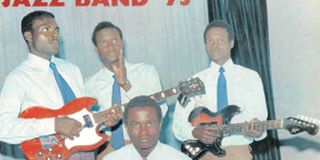He gave the benga beat to Africa

The late Phares Oluoch Kanindo (inset). He may have made national headlines as a politician, but Kanindo leaves a huge footprint in arguably the most influential era in Kenyan music production. PHOTO/COURTESY
What you need to know:
- One of the benga success stories of the 1970s, Victoria Kings, was a product of Kanindo clever promotion. The band would later split into Victoria A, B, C and D Kings.
- It has been claimed that Kanindo would stir things up by playing bands against each other, dropping some suddenly and giving bigger recording opportunities and visibility to others. This “management style” that revolved around business interests and familial or clan-based loyalties led to the huge production of benga releases during the decade.
The death last week of Phares Oluoch Kanindo, at the age of 72, marks the end of an era for Kenyan music. He may have made national headlines as a politician, where he rose to become an Assistant Minister for Education, but Kanindo leaves a huge footprint in arguably the most influential era in Kenyan music production.
His most important contribution to benga was the ability to spread this genre to many parts of Africa, thanks to his distribution acumen. Kanindo had began his career in the 1960s as a technician with the Kenya News Agency and later with the Voice of Kenya (KBC).
His first foray into the recording business was as a producer for A.I.T Records in Nairobi. He produced Tanzanian bands like Vijana Jazz, Western Jazz, Arusha Jazz and a host of others that made the bus trip to record in Nairobi.
HOUSEHOLD NAME
Kanindo was then appointed as the regional representative of E.M.I Records, at a time when many international labels like CBS, Philips and Phonogram were based in Nairobi.
Benga giants like George Ramogi, D.O. Misiani, George Ojijo would troop to the High Fidelity Studios at Pioneer House in Nairobi to cut their songs with Kanindo and sound engineer George “Yahooz” Fombe.
One of the benga success stories of the 1970s, Victoria Kings, was a product of Kanindo clever promotion. The band would later split into Victoria A, B, C and D Kings.
It has been claimed that Kanindo would stir things up by playing bands against each other, dropping some suddenly and giving bigger recording opportunities and visibility to others. This “management style” that revolved around business interests and familial or clan-based loyalties led to the huge production of benga releases during the decade.
This fast paced guitar-based music spread from Kenya across West and Southern Africa largely due to the producer, who had started various labels, like the self-named Kanindo, Lolwe, Sungura, Oyundi, Duol, under his POK Music Stores. In 1976, he made his first trip to Zaire (DRC), Zambia, Malawi, and Nigeria to promote his records. His company partnered with EMI International and distributed hundreds of recordings across the continent and as far as Europe.
By 1979, Kanindo had become a household name in the region, controlling an industry worth several million shillings, and hopping in a private jet to cut distribution deals across various African cities. He admired the showmanship of the Congolese musicians and it is no surprise that bands under his stable like Victoria Kings, mimicked the style of Kinshasa groups like Orchestre Kiam and Lipua Lipua.
Both groups were started and managed by Kanindo’s business associate, Verkys Kiamangwana and at the time. The legendary saxophonist had quit Franco’s T.P. O.K. Jazz, set up his own group, Veve, and established a label of the same that recorded many hit songs in Nairobi.
In Zimbabwe, then known as Rhodesia, benga became so popular that record buyers called the music by the name that they saw on the labels: Kanindo. Another of the producer’s benga labels was called Sungura; Swahili for ‘rabbit,’ and it, too, became the name given to a faster variation of the music, a spin-off from kanindo.
It is said that many fighters during the independence war in Zimbabwe used to dance to ‘kanindo’ records during the night vigils known as pungwe.
LEAN TIMES
The most prominent pioneers of Sungura, also known as museve, were artists like Leonard Dembo and Simon Chimbetu, whose music provided morale to liberation fighters.
The Bhundu Boys achieved international fame in the 1980s playing a variation of this beat, which they called jit, and it remains the most popular genre of music in Zimbabwe to this day.
Credit is also due to the Kericho-based producer A.P. Chandarana, whose Hundhwe label distributed benga records by Kawere Boys, Migori Super Stars, Nyanza Success and others throughout Western and Southern Africa.
By the beginning of the 1980s, Kenyan benga was submerged in the onslaught of musicians arriving in Nairobi from Tanzania and especially Congo, who had themselves perfected elements of benga to develop a pan African rumba sound.
This was to spell the beginning of a lean period for Kenyan music and the end of the golden era that had largely been crafted by one man: Phares Oluoch Kanindo.
This article is based on the upcoming book Retracing 50 years of Kenya’s Popular Music by Ketebul Music




